
The tunes of the ballads
Though we have sources that indicate that ballads were sung in Scandinavia as early as the 13th and 14th centuries, the earliest Swedish written recordings are from the late 16th century (see Är balladerna medeltida?). Evidence of which tunes were sung dates, however, from far later – mostly from the 19th and 20th centuries. Thus we are unable to be sure as to which melodies were sung previously – though many of the tunes have a modal character (that is to say, scales which deviate from the major/minor tonality and are far older) like other older traditional music. This suggests that they originate from before the 18th century.
It is not uncommon for ballad tunes to end on a tone other than the tonic/keynote – for example, the fifth in the octave below the tonic. Many melodies and variants of melodies are, however, substantially younger and built on triads (belonging to major/minor tonality). Another later element is so-called lilt refrains, which replace the older refrains (or burdens). Some of the tunes – as with the texts – are documented in a number of more or less similar variants. The same tune has been sung to a number of texts, and one and the same text has been sung to a number of tunes. Melodies have travelled between different countries and, for example, across the North Sea. One example of a ballad tune found in both Sweden and the British Isles is one of the best-known tunes of the ballad De två systrarna/The two sisters or Binnorie.
Read more
Jersild: Ballader i skillingtryck. Om interaktion mellan tryckt text och muntligt traderad melodi. Noterat 13.
Jersild: Strofvariationer i balladmelodierna. Noterat 10.


Kommentarer